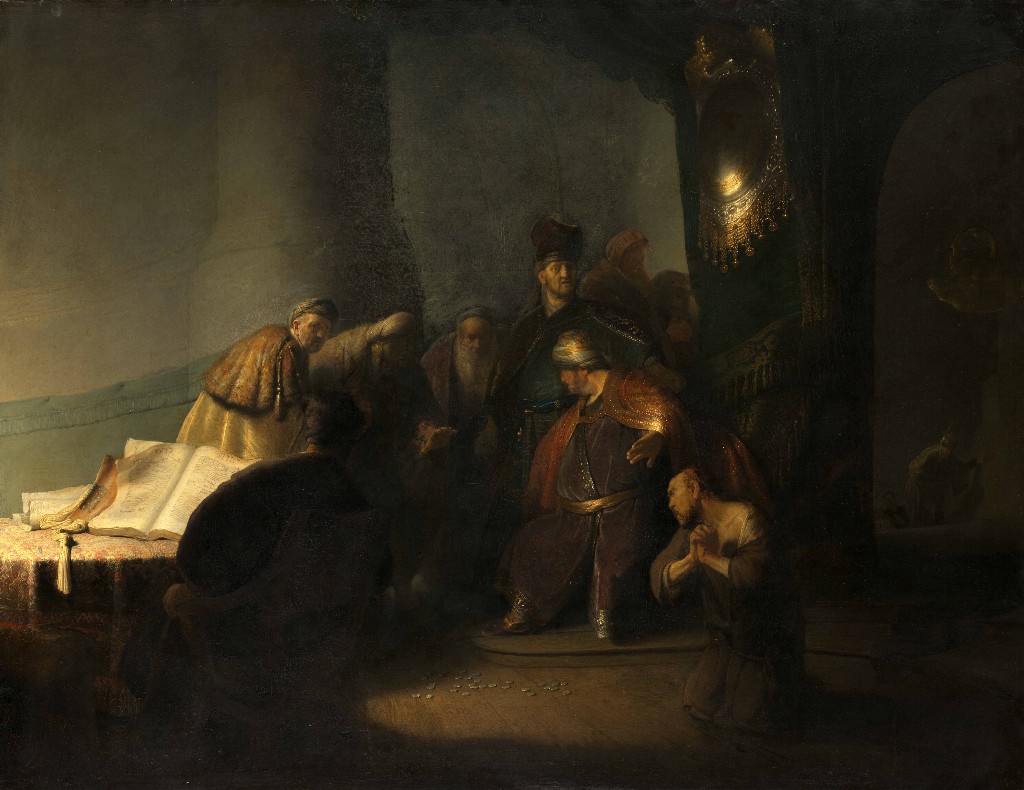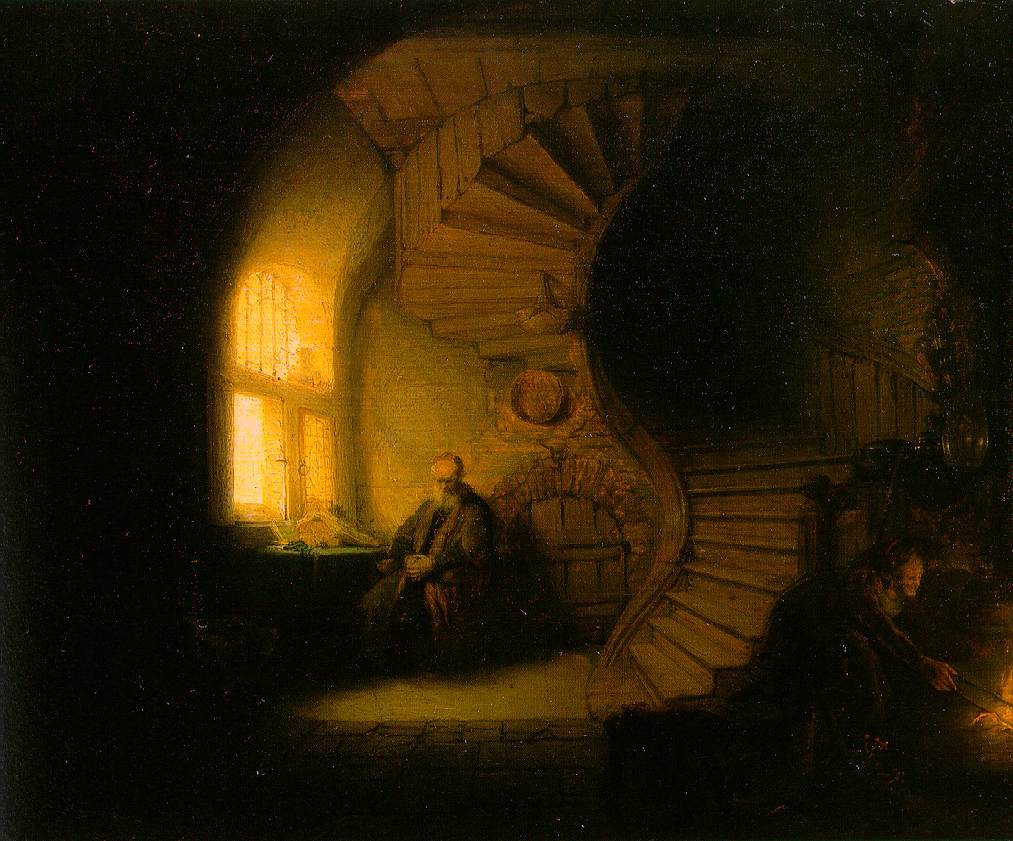Three Ways to See a Painting
Rembrandt’s first masterpiece, and how we see it.

1. I’ve always loved Rembrandt. So after reading a review of Judas Returning the Thirty Pieces of Silver, now at the Morgan, I made a plan to see it. The canvas has never before been exhibited in the United States — it’s in a private collection of Constantine Phipps, 5th Marquesse of Normansby, so it’s usually not available to the public.
A student of mine, Jackson Sabes, met me at the museum. At twenty-three years old, Jackson is the same age Rembrandt was when he painted the picture. Standing in front of the painting, I saw a small horizontal-shaped canvas with mostly close-value earth colors, strong chiaroscuro lighting, smooth paint-handling, and a circular composition. It looked profoundly gloomy. Jackson said he saw Judas on his knees with clenched hands; a group of men — Pharisees — to one side; gold coins in the middle; and to the left, a book with Hebrew letters that he tried and failed to read. Connecting image with title, he remembered the Gospel of Matthew 27 and suggested we go into the lobby for better reception. He read from his iPhone:
When Judas who had betrayed him, saw that Jesus was condemned, he was seized with remorse and returned the thirty pieces of silver to the chief priests — He said, “I have sinned for I have betrayed innocent blood.” The elders respond, “What is that to us? That is your responsibility.” So Judas threw the money into the temple and left. Then he went away and hanged himself.
Rembrandt had chosen the moment after the coin throw. Since this wasn’t a commission, he could have chosen anything. Rembrandt took this theatrical moment, the big dark moment on stage for his first serious picture. It was also a story that most of his viewers would have known.
You see it differently as a painter. I know zero of the Gospels, and I sort of glaze over subjects. I’d have noticed the tortured look, probably seen the little coins in the canvas center, but known nothing about the story, including the imminent suicide.
Constantijn Huygens, connoisseur and poet, wrote about the painting right after seeing it at Rembrandt’s workshop. The original Latin manuscript is in the exhibition:
The gesture of that one despairing Judas . . . that one maddened Judas, screaming, begging for forgiveness, but devoid of hope, all traces of hope erased . . . his gaze wild, his hair torn out by the roots, his garments rent, his arms contorted, his hands clenched until they bleed . . . Even as I write these words I am struck with amazement. All honor to thee, Rembrandt!”
Roger Fry — the art critic, painter, and second Metropolitan Museum curator — developed the theory of Formalism. In a 1913 letter to his Cambridge friend G.L. Dickinson, he wrote, “I want to find out what the function of content is and am developing a theory… that it is merely directive of form and that all the essential aesthetic quality has to do with pure form.” In 1924, he expanded this to, “the emotions resulting from the contemplation of form were more universal (less particularized and coloured by the individual history), more profound and more significant spiritually than any of the emotions which had to do with life….” He believed “that the contemplation of form is a peculiarly important spiritual exercise.” Virginia Woolf quoted this letter in her Fry biography.
Considering pure form — color, shape, texture, placement, and scale — will disregard iconography. His friend Clive Bell came up with a catchier phrase, “Significant Form.” And that’s how I’d been trained to see. Think of everything that came from this: Pollock and Rothko, and the fights over abstraction versus subject matter. From this small observation, from this letter: whole careers, my career too, the careers of critics and magazine founders and anti-magazines.
When I was Jackson’s age, my professors told me that subject matter was déclassé — only philistines, viewers not astute enough to wing it on form and color alone, stooped to consider the painting’s subject. This was the gospel of the second half of the modernist century. A 1960 essay by Clement Greenberg called “Modernism,” which was influenced by Immanuel Kant, Fry’s writing on Formalism, and late nineteenth-century French painting, particularly Manet, claimed that flatness was all. This meant seeing the picture whole.
Subject matter was just illustration. A painting instructor making a chilly reference to illustration — to someone like Norman Rockwell, or Andrew Wyeth — was the kiss of death. Rockwell’s pictures often showed the cute, and the freckled, adoring dogs, families sitting down to late December meals. They were everything the painters of the Pollock generation and after thought American culture had ground and motored through and left behind.
But seeing changes. A few months ago, Manhattan’s West 103rd Street was named after Rockwell. And the Met, that bastion of correct taste, has Rockwell’s Expressman, a 1925 magazine cover in one of its galleries. Rockwell’s Saying Grace — the epitome of Saturday Evening Postness, of what Nabokov called poshlust (and Nabokov has a whole essay about Rockwellism) — sold at auction in 2013 for forty-six million dollars.
Did knowing the subject matter help me see Judas Returning the Thirty Pieces of Silver? Fry would have opined that feeling is solely in the shape — the color and arrangement of objects on a flat two-dimensional wood panel. Knowing the story made me start seeing each thing separately, moving away from painting qua painting. Text, the story of the subject, was a distraction. It’s not about Judas and the silver: it’s about Rembrandt making the painting, and you seeing the painting. It’s an exchange; the subject is the occassion.

Jackson, three generations after me, sees differently. When he was in high school Andy Warhol, with his indelible connection to subject — Elvis Presley, Liz Taylor, the collector Ethel Scull — was, the great artist of the time, sometimes even mentioned in the same breath as Rembrandt. And more recently, art star Jeff Koons, whose Trumpian aesthetic could fit in well at Mar-a-Lago, is completely wedded to subject. (He was also married to Illona Staller, a former porn star.)
Jackson said simply, ”I really need to get my shit together. Rembrandt was great at twenty-three. I saw the van Dyck exhibit last week, that self-portrait when he was seventeen was amazing. And I’m only like on my fourth painting.”
2. Times change, seeing changes, what a culture values changes. Rembrandt doesn’t change much.
Looking at painting is of course dependent on seeing. And how we see is largely based on style, which changes with decades. These days in museums, you see wall labels — now we write about iconography and the story. Sometimes they mention what subjects are wearing. In the middle of the last century, what ran on the wall was a painting’s technique, the color and form, and how the picture fit into a whole career.
As a child, I believed what we saw was pretty standard. Your vision got tested every school year, and if you had 20/20, you didn’t get glasses. Now I know that even if your vision is perfect, you still might not see well. We’ve learned the whole thing is subjective: eyes linked by wiring (that could be faulty) to brains that could be faulty too.
I attempt to teach painting students to see. Only then is it possible to paint. Often what’s called seeing is really hoping — i.e. that your idea came across, that the picture is as good as you believe it to be. That your classmates and strangers will like you because of it. In the nineteen-sixties, German painter Josef Albers wrote that teaching art “was not a matter of imparting rules, styles, or techniques, but of leading students to a greater awareness of what they were seeing.” Albers said his goal as a teacher was “to open eyes.” In an 1844 essay “Experience” Ralph Waldo Emerson wrote, “Thus inevitably does the universe wear our color. As I am so I see.”
Through brain imaging, we’ve learned the brain and the eye are basically one. Visual information passes through pupils to the retina, then travels to the brain for processing. Which means also that seeing is based on training and interpretation; ultimately it’s an expression of the self. Emerson was right — what you see is who you are.
3. Marcel Proust, for me a prose Rembrandt, was also a great admirer of our painter. (His other favorite was Vermeer.) In his À la recherche du temps perdu Proust brings up several Rembrandt paintings. In À l’ombre des jeunes filles en fleur, the narrator is riding in an old-fashioned elevator with the lift boy (translation mine):
It was now he who remained without receiving responses in the short crossing during which he conducted the bow through the hotel, hollow like a toy and which deployed floor after floor around us, its branching corridors in the depth of which a so-velvety light debased itself, reduced the thickness of communicating doors, the steps of interior stairs, which were converted into that amber gold, inconsistent and mysterious as dusk, where Rembrandt sometimes silhouettes the support of a window or the handle of a well.
Proust must have known The Philosopher in Meditation from Louvre trips. With its small scale, horizontal format, distant view perspective, and chiaroscuro lighting it hearkens back to the Judas from three years before. But it’s quieter, warmer and sans religion.

Proust also wrote a fictional account of ninteenth-century aesthete John Ruskin visiting a Rembrandt exhibition in Amsterdam. Proust took this trip himself in 1902 to see the 125 Rembrandts. (Having died in 1900, Ruskin couldn’t have.) He imagines Ruskin going through the exhibition with his housekeeper (in Proust, there’s always a housekeeper). He experiences “a sort of golden medium, as if they had been painted in a similar light.” Proust extols the painter with a famous definition of art:
Thanks to art, instead of seeing one world only, our own, we see that world multiply itself and we have at our disposal as many worlds as there are original artists, worlds more different one from the other than those which revolve in infinite space, worlds which, centuries after the extinction of the fire from which their light first emanated, whether it is called Rembrandt or Vermeer, send us still each one its special radiance.
Judas Returning the Thirty Pieces of Silver has both the timely and the eternal. It transcends 1629 in Leiden, Holland, and rewards our viewing: that’s when a paintings lives, gets free and can time travel. Think of all the eyes that have looked upon this picture and, by looking, have added to it.
How different everything was three hundred and eighty-seven years ago when Rembrandt painted this picture. All that time stretching between the Leiden workshop and our quick moment in time — from a world where there was no electricity, no cellular phone service, no AR-15-style semi-automatic, to the moment in June when the picture took its spot on the wall of the Morgan Library and Museum, in the city of New York. Someone hung it, and someone walked away. As Fry said it’s spiritual. For me it’s the religion of art.
Pat Lipsky is a painter and writer. She has recently completed a memoir, Art: A Disillusioning. Her paintings are in 23 museum collections, including the Whitney, Houston Museum of Fine Arts, the US Embassy in Kabul, Afghanistan, US Department of State, and the Hirshhorn. She’s had 29 one-woman exhibitions.
